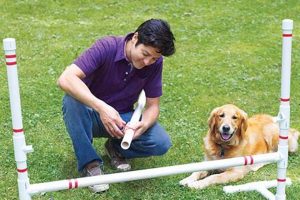The concept involves creating stimulating playthings at home using readily available materials, designed to engage a canine’s natural instincts and mental capabilities. For instance, an empty cardboard box filled with crumpled paper and hidden treats encourages foraging behavior. This approach offers a cost-effective alternative to commercially produced items.
The significance lies in its contribution to a dog’s overall well-being. Mental stimulation reduces boredom, which can lead to destructive behaviors. Furthermore, these activities promote problem-solving skills and provide an outlet for pent-up energy. Historically, owners have adapted household items to entertain their pets, reflecting a long-standing recognition of the need for canine enrichment.
The subsequent discussion will delve into specific examples of homemade interactive devices, the types of materials suitable for their construction, and crucial safety considerations to ensure a positive and secure experience for the animal.
Tips for Homemade Canine Stimulation Devices
The following guidelines are crucial when designing and implementing homemade interactive devices for canine enrichment. Prioritize safety and suitability for the individual animal.
Tip 1: Material Selection: Choose non-toxic materials. Avoid small parts that can be ingested, sharp edges, or materials that splinter easily. Durable fabrics like fleece or canvas are preferable to easily torn or shredded materials.
Tip 2: Supervision is Paramount: Always supervise the dog during initial interactions with a new homemade device. This allows for the identification and correction of any potential hazards or inappropriate behaviors.
Tip 3: Gradual Introduction: Introduce new devices gradually. Start with simple designs and progressively increase the complexity as the dog’s problem-solving skills improve. Avoid overwhelming the animal with overly challenging tasks.
Tip 4: Hygiene and Maintenance: Regularly clean homemade devices to prevent the build-up of bacteria and debris. Discard items that are damaged or worn to minimize the risk of ingestion or injury.
Tip 5: Consider the Dog’s Temperament: Tailor the device to the dog’s individual personality and energy level. A high-energy dog may benefit from a more physically demanding activity, while a more cautious dog may prefer a simpler, puzzle-based design.
Tip 6: Size Matters: Ensure the device is appropriately sized for the dog. Items that are too small can be choking hazards, while items that are too large may be difficult for the dog to manipulate.
Tip 7: Rotation of Items: Rotate the availability of stimulation devices to maintain the dog’s interest and prevent boredom. Introducing new items regularly helps to sustain engagement and novelty.
Implementing these suggestions can result in a more secure and effective implementation of homemade enrichment strategies, leading to a happier, healthier, and more well-adjusted canine companion.
The subsequent section will address specific designs and project ideas, focusing on practical application of the discussed principles.
1. Safety First
The principle of “Safety First” is paramount when constructing and providing homemade interactive items for canine enrichment. A failure to prioritize safety can result in adverse effects, ranging from minor injuries to serious health complications. Cause and effect are directly linked: unsafe components or designs lead to potential harm. As a core component, “Safety First” ensures the enrichment activity remains beneficial, not detrimental, to the animal’s well-being. A real-life example would be the use of PVC pipes for treat dispensers. While seemingly durable, PVC can splinter if chewed aggressively, leading to internal injuries. Replacing PVC with a more pliable and non-toxic material, such as food-grade silicone, directly addresses this safety concern. The practical significance of this understanding is that it guides responsible creation, mitigating risks inherent in unregulated homemade projects.
Further analysis reveals that material selection is critical. Fabrics should be durable enough to resist tearing and ingestion, stuffing should be non-toxic and securely contained, and any adhesives used must be animal-safe. Sharp edges, small detachable parts, and materials that can easily splinter pose significant threats. For instance, buttons or beads sewn onto fabric toys can be easily detached and swallowed, causing choking hazards or intestinal blockages. Similarly, ropes or string can unravel and become entangled, posing a strangulation risk. Practical application involves diligent inspection of materials and construction techniques, ensuring all components are securely fastened and non-toxic.
In conclusion, prioritizing “Safety First” in the context of homemade enrichment involves careful material selection, meticulous construction, and ongoing monitoring. The challenge lies in proactively identifying and mitigating potential hazards. Adhering to this principle transforms potentially dangerous projects into enriching and safe experiences for canines, thereby enhancing their overall quality of life. This focus directly links to the broader theme of responsible pet ownership and the provision of a secure and stimulating environment for canine companions.
2. Material Appropriateness
The selection of suitable materials is fundamental to the success and safety of DIY dog enrichment toys. The principle of “Material Appropriateness” dictates that only substances that are non-toxic, durable, and appropriate for the intended use should be incorporated into these enrichment devices. Failure to adhere to this principle can have direct, negative consequences for the animal. For instance, using chemically treated wood in a chew toy can lead to ingestion of harmful substances, causing illness. Conversely, employing robust, untreated wood designed for canine interaction promotes safe and prolonged engagement. The importance of this consideration stems from the direct correlation between material safety and the dog’s well-being.
Further analysis reveals that material choice extends beyond mere toxicity. The texture, size, and structural integrity of the material also play a critical role. Easily shredded fabrics can lead to intestinal blockages if ingested. Small components, such as buttons or plastic eyes, pose choking hazards. Sharp edges or brittle materials can cause lacerations or puncture wounds. Practical application involves conducting thorough risk assessments of each material before incorporating it into a toy. This includes evaluating its resistance to tearing, chewing, and weathering, as well as its potential to leach harmful chemicals. For example, replacing conventional stuffing with tightly packed fleece reduces the risk of ingestion and subsequent intestinal problems.
In conclusion, “Material Appropriateness” is not merely a guideline but a necessity in the context of DIY dog enrichment toys. The challenge lies in proactively identifying and mitigating potential hazards through informed material selection. By prioritizing safety and durability, creators can ensure that these homemade devices contribute positively to the dog’s mental and physical stimulation, without compromising its health or well-being. This approach aligns with responsible pet ownership and emphasizes the importance of creating a safe and enriching environment for canine companions.
3. Stimulation Variety
Stimulation variety is a crucial element in the realm of homemade canine enrichment devices. Without a diverse range of stimuli, the intended benefits of mental and physical engagement diminish significantly, potentially leading to boredom and the resurgence of undesirable behaviors.
- Scent Work Implementation
Introducing scent-based activities enhances cognitive function by engaging the olfactory senses. For example, creating a snuffle mat from fleece strips allows the dispersal of treats, requiring the dog to use its sense of smell to locate them. This contrasts with visual-based tasks and provides a different form of mental exertion.
- Puzzle Complexity Progression
Varying the difficulty level of puzzle toys prevents the dog from becoming desensitized to the challenge. A simple puzzle involving lifting cups to retrieve treats can be advanced to a multi-step process requiring manipulation of levers or rotating components. This progressive complexity maintains engagement and promotes problem-solving skills.
- Texture and Material Diversity
Incorporating a range of textures and materials into enrichment devices stimulates tactile senses and provides varied sensory input. Combining soft fabrics like fleece with rougher materials like rope or durable rubber introduces novelty and prevents sensory monotony. Toys solely made of one texture may lose their appeal over time.
- Auditory Stimulation Components
Introducing auditory elements, such as crinkling materials or squeaking devices, can pique a dog’s interest and encourage interaction. Integrating these components into homemade toys adds another layer of sensory engagement, appealing to a wider range of canine preferences. However, auditory stimulation must be carefully controlled to avoid overstimulation or anxiety.
The incorporation of diverse stimuli into DIY canine enrichment items directly impacts their effectiveness in promoting mental and physical well-being. A balanced approach to stimulation variety ensures that these homemade devices continue to provide ongoing engagement and prevent the onset of boredom, solidifying their role as valuable tools in responsible pet ownership.
4. Durability
Durability is a critical factor in the design and construction of DIY dog enrichment toys. The lifespan of these items, and consequently their long-term benefit, hinges on their ability to withstand repeated use and potential abuse from canine interaction. Poorly constructed, fragile toys present safety hazards and require frequent replacement, negating the cost-effectiveness and environmental benefits of the DIY approach.
- Material Strength and Resistance
The inherent strength of the chosen materials directly affects the toy’s longevity. For example, a toy constructed from thin cardboard is unlikely to withstand repeated chewing or tearing. Opting for thicker, more resilient materials like heavy-duty canvas or repurposed denim significantly extends the toy’s lifespan. Furthermore, resistance to moisture, UV exposure, and abrasion are important considerations, particularly for toys intended for outdoor use.
- Construction Techniques and Reinforcement
Sound construction techniques are essential to maximizing the toy’s ability to endure canine interaction. Weak seams, poorly secured attachments, or inadequate reinforcement can lead to premature failure. Double-stitching seams, using durable knots, and reinforcing stress points with additional material are crucial for extending the toy’s life. The specific construction method should be tailored to the materials and intended use of the toy.
- Resistance to Disassembly and Ingestion
A durable toy must resist being easily disassembled by the dog. Components that are easily detached pose a choking hazard or can be ingested, leading to potentially serious health problems. Securely attaching all components and avoiding small, detachable parts are crucial design considerations. The toy should be designed in a way that prevents the dog from accessing internal stuffing or other potentially harmful materials.
- Maintenance and Repair Considerations
Durability also extends to the ease with which a toy can be maintained and repaired. Toys constructed from materials that are easily cleaned and patched are more likely to be used long-term. Regular inspection for wear and tear, followed by timely repairs, can significantly extend the toy’s lifespan. Designing toys with replaceable parts or modular construction facilitates easier maintenance and repair.
These facets of durability collectively determine the long-term value and safety of homemade canine enrichment toys. Investing in robust materials and employing sound construction practices ensures that these items provide lasting mental and physical stimulation for dogs, while minimizing the risks associated with premature wear and tear or potential ingestion of components. A focus on durability aligns with principles of responsible pet ownership and sustainable resource utilization.
5. Canine Engagement
Canine engagement represents the level of interest and active participation a dog exhibits during interaction with an enrichment device. Its direct connection to homemade interactive devices is that successful enrichment hinges on capturing and sustaining the animal’s attention. Devices failing to engage the canine’s natural instincts, such as foraging, problem-solving, or play, render the enrichment efforts ineffective. A poorly designed puzzle toy, for instance, may be easily solved or prove too difficult, resulting in frustration or disinterest. The consequence of low engagement is the continuation of boredom-related behaviors, such as destructive chewing or excessive barking. Therefore, engagement is not merely a desirable outcome but a fundamental prerequisite for effective canine enrichment.
Analysis reveals that several factors influence canine engagement with enrichment toys. These include the novelty of the device, the degree of challenge it presents, and its alignment with the dog’s individual preferences and abilities. A new toy, even a simple one, often elicits initial interest. However, sustained engagement requires a progressive level of challenge, gradually increasing the complexity as the dog’s skills develop. Moreover, toys that appeal to a dog’s specific breed characteristics or individual preferences are more likely to hold their attention. A herding breed, for example, may find greater enjoyment in toys that mimic the movement of livestock, while a scent-hound may be more engaged by devices that incorporate strong olfactory stimuli. Practical application involves careful observation of the dog’s behavior during interaction with different enrichment devices, noting their preferences and adapting the toys accordingly.
In conclusion, canine engagement is inextricably linked to the effectiveness of homemade canine enrichment toys. The challenge lies in creating devices that not only capture initial interest but also provide sustained mental and physical stimulation, adapting to the dog’s evolving skills and preferences. By prioritizing engagement in the design and implementation of these toys, owners can promote a more fulfilling and well-adjusted life for their canine companions, mitigating the risks associated with boredom and inactivity. This focus aligns with the broader theme of responsible pet ownership and the provision of a stimulating and enriching environment for animals.
Frequently Asked Questions
The following addresses common inquiries regarding the creation and utilization of homemade canine interactive devices, providing clarity on best practices and potential challenges.
Question 1: Are all household items safe for use in DIY dog enrichment toys?
No, many common household items pose risks to canine health and safety. Materials such as small plastic components, chemically treated wood, and toxic adhesives are inappropriate for toy construction. Comprehensive research into material safety is crucial prior to initiating any DIY project.
Question 2: How frequently should a dog be provided with enrichment activities?
The frequency depends on the individual dog’s energy level, breed, and temperament. High-energy breeds typically require more frequent enrichment opportunities than less active dogs. Daily engagement with enrichment activities is generally recommended to prevent boredom and promote mental stimulation.
Question 3: What are the signs of overstimulation in dogs engaged in enrichment activities?
Signs of overstimulation can include excessive panting, pacing, whining, and an inability to focus. If a dog exhibits these behaviors, the activity should be immediately discontinued, and the dog should be provided with a quiet space to decompress. Subsequent enrichment activities should be less intense and of shorter duration.
Question 4: How can the difficulty of DIY dog enrichment toys be adjusted to suit different dogs?
The difficulty level can be modified by altering the complexity of the puzzle, the size of the treats used, and the level of physical dexterity required. Start with simple designs and gradually increase the challenge as the dog’s problem-solving skills improve. Observational assessment of the dog’s performance is crucial for determining the appropriate level of difficulty.
Question 5: What are the best methods for cleaning and maintaining DIY dog enrichment toys?
Cleaning methods depend on the materials used in the toy’s construction. Fabric toys can typically be machine washed, while plastic or rubber toys can be cleaned with soap and water. Regular cleaning is essential to prevent the buildup of bacteria and maintain hygiene. Damaged toys should be repaired or discarded to prevent injury.
Question 6: Is it necessary to supervise dogs during interaction with DIY enrichment toys?
Yes, supervision is paramount, particularly during initial interactions with new toys. This allows for the immediate detection of potential hazards, such as the ingestion of small parts or the development of destructive behaviors. Constant observation ensures a safe and positive enrichment experience for the animal.
In summation, the successful implementation of homemade interactive devices demands careful consideration of safety, individual canine needs, and diligent maintenance. Responsible creation mitigates risks and maximizes the potential for positive enrichment outcomes.
The following segment will offer step-by-step instructions for constructing specific enrichment items.
Conclusion
This exploration of diy dog enrichment toys has underscored the importance of safety, material appropriateness, stimulation variety, durability, and canine engagement in their construction and utilization. These elements collectively contribute to the creation of effective and safe interactive devices designed to promote mental and physical well-being in canines.
By adhering to the principles outlined, individuals can create enriching experiences for their canine companions, mitigating the risks associated with boredom and inactivity. Continued diligence in the design, implementation, and maintenance of these devices will contribute to improved canine welfare and strengthened human-animal bonds. The understanding and responsible application of these concepts represent a significant step toward enhanced pet ownership.







